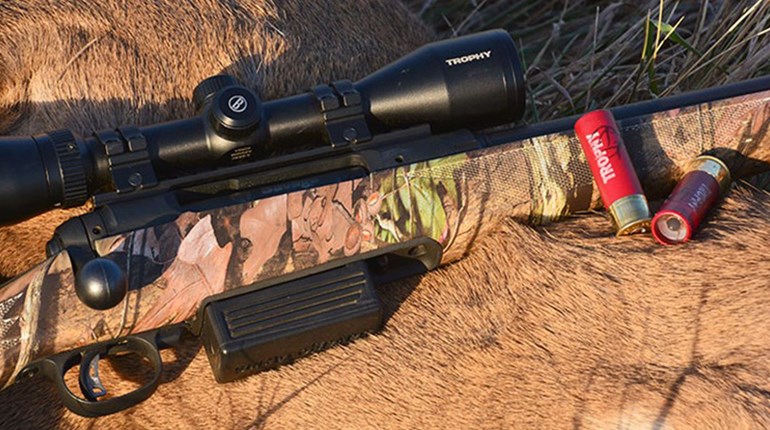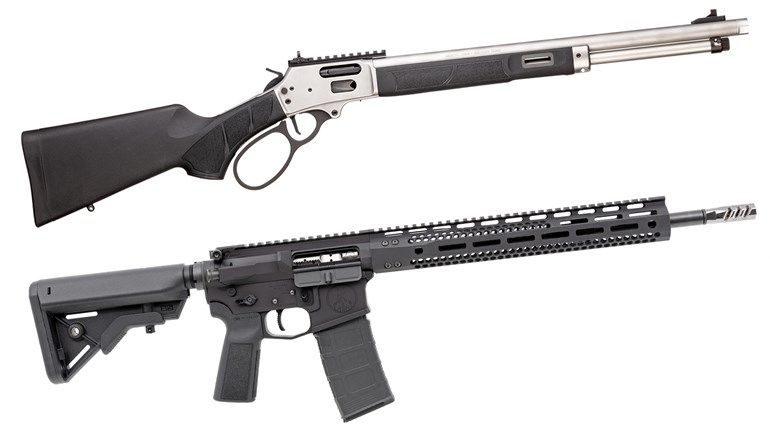
Right now, there’s a guy on a stool in a gun shop arguing over what the “best home defense gun” is. Whether he’s right or wrong isn’t relevant—the best gun for home defense is the gun you have when you need it. For many families, that gun isn’t a tricked-out AR, a shotgun with a light bright enough to blind the neighbors across the street, or a laser-gripped Glock; it’s the gun that puts food on the table and trophies on the wall. Though most hunting guns aren’t designed to save a life, they can get it done if they’re your only option. Employing a hunting gun for self-defense purposes takes some special consideration, and now is the time to make a plan—not at when the front door gets kicked-in at 3 a.m.
The biggest challenge in using traditional hunting arms for self-defense is their size. A rifle with a 24” barrel or a shotgun with even longer dimensions isn’t ideal for navigating the interior of a home. Not only are such firearms unwieldy when it comes to hallways and corners, they are far easier for bad guys to grab onto. This is a non-issue if your home defense plan is to arm yourself and stay in-place as you wait for the police to show up, but if you need to make your way through the house to get to your kids, the ability to move while armed is important. If you have a carbine such as the Marlin 336 in your hunting battery, I would choose it for home defense over more cumbersome firearms.
Most hunting rifles these days wear scopes, which can be a challenge at close range. If your hunting scope is a variable power, be sure to keep it on its lowest power setting for defensive use and experiment to determine whether it is useable in low light—if you can’t readily identify what you’re shooting at, you shouldn’t be shooting. A low-range variable such as Leupold’s 1.5-5x20mm with an illuminated reticle would be a great choice for a combination hunting/defensive optic as would something like the Trijicon Accupoint 1-4x24mm which gets it done with no batteries. Spend some time at the range practicing shooting with your scope at close range and try your best to do it with both eyes open. Take note of where your bullet impacts on the target—your point of aim is likely to be far different at 10 yards than it is at 100. A few inches doesn’t seem like much but could mean life or death during a violent encounter.
When it comes to hunting rifles, their strength can also be a limitation: power. On one hand, a hunting rifle chambered in .270 Win. or .30-06 Sprg. is going to have no problem taking a home invader out of the fight, on the other hand, the risk of over-penetration when firing such a cartridge in a home is significant. Advances in bullet technology have been a boon to big game hunters but bullets designed to traverse the length of an elk or moose are a bad idea when the only thing separating your muzzle from your loved ones or neighbors is drywall and wood. Light-for-caliber bullets suitable for varmints are probably the best bet in such circumstances as they stand the least chance of maintaining their integrity as they hit hard objects. Beware of “frangible” training ammunition for home defense. Such bullets are designed to come apart when hitting steel and can act like FMJ rounds on softer construction materials. The most important thing to keep in mind here is knowing your target and what is beyond it. Spend some time walking around your house thinking about the positions of bedrooms, good backstops such as brick walls and other considerations while you have a clear head—making such decisions under the stress of a violent break-in is a recipe for disaster.
Ammo selection for shotguns is far easier as there are plenty of shot loads that aren’t prone to over-penetration. Many recommend light bird loads such as #8s for home defense under the theory that the pellets won’t penetrate drywall. For that exact reason, no shotgun of mine gets loaded with dove or target loads unless I’m shooting at birds or clay—I don’t want someone intending to doing harm to my family to be able to use drywall as hard cover. Your own living situation and judgment determines the best course of action for your particular circumstances—use your head. If you use a hunting shotgun for defensive purposes, I would recommend that you store it with an open choke such as an Improved Cylinder as it will give you a pattern more suitable for defensive situations than tighter chokes. It is a general principle that a cylinder-choked shotgun with 00 buck will spread approximately 1” per yard of distance to the target. For example, at 7 yards, you’ll have a 7” shot pattern: long-barreled hunting shotguns will probably spread a bit less as this is based on 20” barrels. If your hunting shotgun is a pump or semi-auto, a really wise and cost effective purchase would be a shorter barrel. I fitted my Remington 870 turkey gun with an aftermarket $100 barrel that knocked 10” off the overall length and made it a great home defense shotgun. I can put the turkey barrel back on in under a minute if I’m going to chase gobblers.
The best gun for any situation is the one that you have with you at the time: home defense scenarios are no exception. If the only firearms in your home are deer rifles and bird guns, don’t despair—but don’t assume that you’re ready for anything, either. You have a responsibly to do your homework and ensure that the tool you’ve chosen for the job is not only effective, but that you’re prepared to use it safely. Knowing the limitations and capabilities of your home defense firearm is part of being a responsible gun owner. Taken the time and make a plan.





































